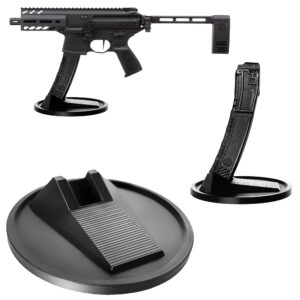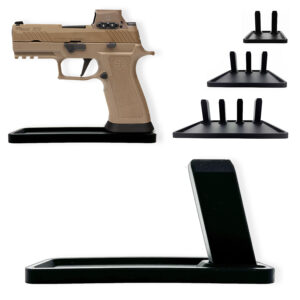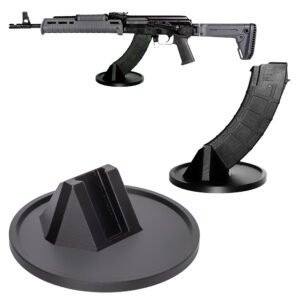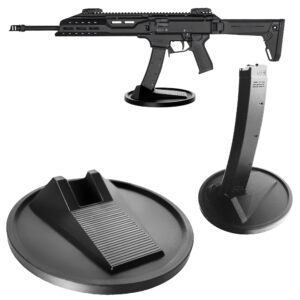
Categories:
Introduction To AR15, SBR, And AR-15 Pistol
The AR-15 platform has become one of the most popular guns among gun enthusiasts and sports shooters alike. Renowned for its versatility, accuracy, and customizable features, the AR-15 offers a wide range of options to suit individual preferences. Additionally, two variations of the standard AR-15 have gained significant popularity in recent years: the Short Barrel Rifle (SBR) and the AR-15 pistol.
The AR-15 is a semi-automatic rifle that originated from the military’s M16 rifle. It is chambered in .223/5.56mm caliber and boasts a lightweight design due to its aluminum receiver. The modularity of this gun allows owners to modify various parts like stocks, handguards, barrels, triggers, and optics according to their shooting needs or personal style. On the other hand, an SBR is an AR-15 with a barrel length shorter than 16 inches but still equipped with a stock.
This compact size makes it ideal for close-quarter engagements or situations where maneuverability is crucial. Lastly, an AR-15 pistol features a barrel length shorter than 16 inches but lacks a stock attachment point. This configuration allows for one-handed shooting when necessary while maintaining the familiarity of an AR-style platform.
Properly maintaining your AR-15, SBR, or AR-15 pistol is essential to ensure its longevity and optimal performance. To clean these guns effectively, it is crucial to have the right cleaning supplies at hand. Here are the necessary items you will need:
Before beginning any cleaning process, it is crucial to prioritize gun safety. Unloading your AR-15, SBR (Short Barreled Rifle), or AR-15 pistol properly is the first step in maintaining a safe environment while handling guns. Start by removing the magazine from your gun. Press the magazine release button located near the trigger guard to release it. Once removed, visually inspect the chamber to ensure there are no rounds present.
Remember to keep your finger off the trigger at all times during this process. Next, retract and lock back the bolt carrier group (BCG) by pulling back on the charging handle until it locks in place. This will allow you to visually inspect both the chamber and magazine well for any remaining ammunition or obstructions. To double-check that your gun is unloaded, perform a physical inspection by inserting a finger into the chamber and visually ensuring it’s clear of any rounds or debris.
However, never place your finger on or near the trigger while performing this check. Finally, engage the safety selector switch into its “safe” position if applicable. This extra precaution ensures that even if you accidentally manipulate the trigger, no discharge can occur. Remember that proper gun safety practices should always be followed when handling any type of gun, including during cleaning procedures.
Field stripping an AR-15, SBR (short-barreled rifle), or AR-15 pistol is an essential skill for every owner. This process allows for thorough cleaning and routine maintenance of these guns. While the specific steps may vary slightly depending on the manufacturer and model, the basic principles remain the same. To begin field stripping, ensure that the gun is unloaded and remove any ammunition from your work area.
Start by pulling back on the charging handle to lock the bolt carrier group (BCG) to the rear. Engage the safety selector to prevent any accidental discharges. Next, push out both takedown pins located above and below the trigger guard simultaneously. Once released, carefully separate the upper receiver from the lower receiver by pivoting them open like a clamshell. With both receivers separated, pull out and remove the BCG along with its charging handle from the upper receiver.
Take note of any dirt or fouling present on these components as you inspect them. Now it’s time to clean each part individually using appropriate tools and cleaning solvents. Pay close attention to areas prone to carbon buildup such as inside the barrel chamber, bore, bolt face, and gas system components. After cleaning each part thoroughly, reassemble your gun in reverse order using caution not to force any parts together.
The upper receiver and bolt carrier group are vital components of an AR-15, SBR, or AR-15 pistol that require regular cleaning to maintain optimal performance. To ensure the longevity and reliability of your gun, follow these steps for proper cleaning. Begin by removing the upper receiver from the lower receiver. This can be done by pulling back on the takedown pin and separating the two halves.
Next, disassemble the bolt carrier group by removing the firing pin retaining pin located at the rear of the bolt carrier. Once removed, slide out the firing pin, cam pin, and bolt. Using a nylon brush or toothbrush dipped in a solvent cleaner, scrub all visible carbon buildup from each component. Pay close attention to areas like gas rings, extractor grooves, and inside the bolt carrier itself.
After scrubbing away debris, wipe down all parts with a clean cloth to remove excess solvent and carbon residue. Ensure that no lint or debris remains on any component as this could affect functionality. Inspect each part for signs of wear or damage. Replace any worn-out components as necessary to maintain reliable operation. Once all parts are cleaned and inspected thoroughly, apply a light coat of lubricant specifically designed for guns.
Ensure that all moving parts have a thin layer of lubrication to promote smooth operation.
Cleaning the barrel and gas system of your AR-15, SBR (Short Barrel Rifle), or AR-15 pistol is crucial to ensure its optimal performance and longevity. Here’s a step-by-step guide on how to effectively clean these components. 1. Safety First: Always make sure your gun is unloaded before beginning any cleaning procedure. Remove the magazine, lock the bolt back, and visually inspect the chamber.
Proper lubrication is crucial for maintaining the smooth functioning of your AR-15, SBR, or AR-15 pistol. It not only ensures reliable performance but also protects the gun against excessive wear and tear. Here are some key components that require adequate lubrication:
Apply a small amount of lubricant to the charging handle latch and pivot points to ensure smooth movement. 3. Barrel Extension: The barrel extension houses the locking lugs that engage with the bolt carrier group during firing. A light application of gun oil on these contact points minimizes friction and helps maintain accuracy. 4. Trigger Assembly: To ensure consistent trigger pull and reset, lightly lubricate the trigger assembly components such as pins, springs, disconnector, and sear engagement surfaces.
Remember to avoid over-lubricating as excess oil can attract debris or cause malfunctions due to hydraulic lock-up in extreme temperatures.
Once you have finished cleaning your AR-15, SBR, or AR-15 pistol, it’s essential to reassemble the gun correctly to ensure its proper functioning. Follow these steps carefully:
After completing the cleaning process for your AR-15, SBR, or AR-15 pistol, it is essential to perform a function check to ensure that your gun is in proper working condition. Here are the final steps you should take before storing your weapon. 1. Safety First: Before conducting any function check, ensure that the gun is unloaded and the safety selector is in the safe position.
Pay attention to any abnormal sounds or malfunctions during this step. 3. Inspection and Lubrication: Once you have confirmed that your gun functions properly, inspect all external parts for cleanliness and ensure they are well-lubricated according to manufacturer recommendations. 4. Proper Storage: To preserve its longevity and prevent rust or damage, store your AR-15 in a suitable case or safe that provides protection from dust, moisture, and unauthorized access.
Keep ammunition separate from guns during storage for safety purposes.








Colt
Colt M4 Carbine
Colt LE6920
Colt AR-15 A4
Daniel Defense
DDM4 V7
DDM4 V9
DDM4 V11
DDM4 ISR (Integrally Suppressed Rifle)
Smith & Wesson (S&W)
M&P15 Sport II
M&P15 Tactical
M&P15T
Bravo Company Manufacturing (BCM)
BCM Recce-16
BCM Recce-14
BCM MCMR Series
Aero Precision
M4E1 Series
AC-15
AR15 Pistol (Various Configurations)
Ruger
Ruger AR-556
Ruger SR-556
Ruger AR-556 MPR (Multi-Purpose Rifle)
Springfield Armory
Saint Victor
Saint Edge
Saint AR-15
PSA (Palmetto State Armory)
PSA PA-15
PSA AR-V
PSA Jakl (AR Pistol)
FN America
FN 15 Tactical Carbine
FN 15 Patrol
FN 15 DMR
Wilson Combat
Recon Tactical
Super Sniper
Protector Carbine
SIG Sauer
SIG M400 Tread
SIG M400 Elite
SIG M400 SDI
LWRC International
IC DI (Direct Impingement)
IC SPR
IC A5
Bushmaster Guns
XM-15 QRC
Bushmaster MOE
XM-15 Patrolman
Rock River Arms
LAR-15 Entry Tactical
LAR-15 Predator
LAR-15 Elite Comp
Stag Arms
Stag 15 Tactical
Stag 15L (Left-Handed Models)
Stag 15 Valkyrie
Noveske Rifleworks
Noveske Gen 4 N4
Noveske Space Invader (AR Pistol)
Noveske Recon
Anderson Manufacturing
AM-15 Optic Ready
AM-15 M4 Carbine
AM-15 Precision Rifle
Adams Arms
AA-15 Piston Rifle
P2 AARS (Adams Arms Rifle Series)
Black Rain Ordnance
SPEC15 Series
BRO Predator
Fallout 15
Diamondback Guns
DB15 Series
DB15CCMLB
DB15EB
Del-Ton Inc.
DTI-15
Del-Ton Echo 316H
Sierra 316M
Windham Weaponry
Windham SRC
Windham VEX-SS
Windham RMCS-4 (Caliber Conversion System)
Christensen Arms
CA-15 G2
CA-15 Recon
CA-15 Titanium Edition
Patriot Ordnance Factory (POF-USA)
Renegade Plus
P415 Edge
Revolution DI
LaRue Tactical
PredatAR
OBR (Optimized Battle Rifle)
LaRue Stealth 2.0
Battle Arms Development
Workhorse Patrol Carbine
BAD556-LW (Lightweight)
Authority Elite Rifle
Faxon Guns
Ascent AR-15
FX-19 (AR Pistol)
Streamline Ultralight Series
KE Arms
KE-15 SLT (Super Lightweight Tactical)
KE-15 Scout Carbine
Primary Weapons Systems (PWS)
MK1 MOD 2-M
MK116 PRO
MK107 (Piston AR Pistol)
ZEV Technologies
ZEV Core Elite Rifle
ZEV AR15 Billet Rifles
Franklin Armory
BFSIII AR-C1
Militia Model
F17-L (Chambered in .17 WSM)
Seekins Precision
SP15 DMR
NX15 Skeletonized Rifle
Havak Bravo
Aero Precision (Additional Models)
EPC-9 (Pistol Caliber ARs)
VG6 AR Rifles
Barrett Guns
REC7 DI
REC7 Gen II
CMMG
MK4 RCE
Resolute 300
Banshee (AR Pistol)
DPMS Panther Arms
Panther Oracle
Panther LR-308
H&K (Heckler & Koch)
HK MR556A1
HK416 (Military Variant)
Rock Island Armory (Armscor)
VR-80 Tactical AR (Shotgun AR Platform)
Troy Industries
Troy SPC-A3
Troy PAR (Pump Action AR)
Wilson Tactical
Tactical Recon AR
Protector Series
F1 Guns
FDR-15 Skeletonized Rifle
BDRx-15 Series
Juggernaut Tactical
JT-15
JT-10 Precision Rifle
AeroSurplus
Surplus AR-15 Rifles (Budget Models)
Thunder Tactical
AR-15 Basic Carbine
Tactical Builder Sets
Radical Guns
RF-15
Forged AR-Series
Dark Storm Industries
DS-15 Featureless Rifles
DS-10 Typhoon
DRD Tactical
Paratus
Aptus AR Rifles
Bear Creek Arsenal
BCA-15
AR Complete Upper Builds
Aero Survival Rifles (ASI)
ASR Tactical Series
Tactical Edge
WARFIGHTER Series
AR-15 Lightweight Rifles
Lone Star Armory
TX15 DMR
TX15 Carbine
HERA Arms
HERA H7
HERA AR-15 Lower Builds
IWI (Israeli Weapon Industries)
Zion-15
DRD Tactical
Tactical Modular Rifles
Quick-Takedown Rifles
V Seven Weapons
1776 Rifle
Hyperlite Rifle
Core Rifle Systems
Core15 Tac III
Core15 Patrol Rifle
Armalite (Original AR-15 Creator)
M15 Tactical
M15 A4 Carbine
DEF15 (Defensive Sporting Rifle Series)
PSA (Palmetto State Armory Additional Models)
PSAK-47 Hybrid (AR-AK Style Hybrid)
PSA Dagger (Pistol Caliber Configurations)
Odin Works
OTR-15
Odin Recon Rifle
Maxim Defense
MDX-508 PDX (Compact AR Pistol)
MDX-510 Rifle